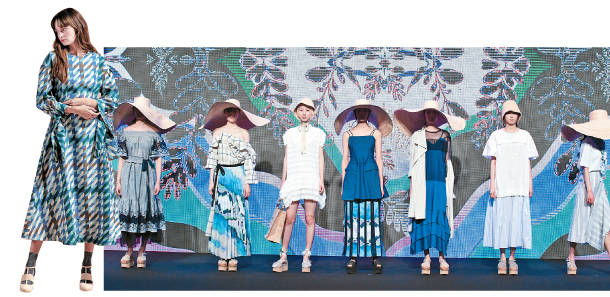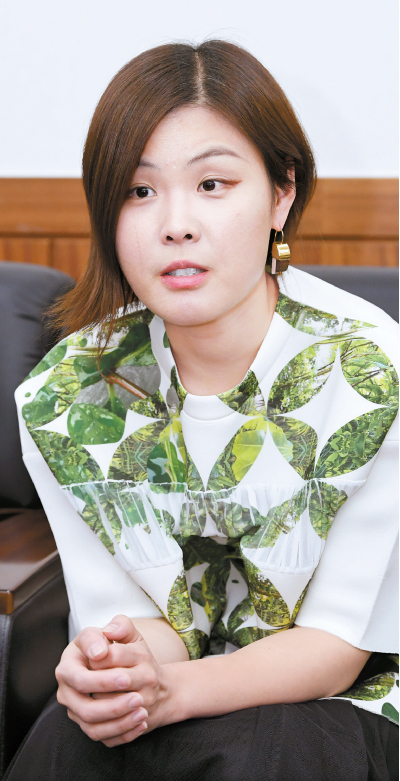Focused on sustainable fashion: Designer Cho Eun-ae keeps busy with her brand tibaeg and a new children’s line

Above: Models wear tibaeg’s 2019 S/S collection pieces during a fashion show at the K Fashion Audition Trend Fair on May 9. The event was held by the Ministry of Trade, Industry and Energy to support domestic fashion designers. Left: A look from tibaeg’s 2019 F/W collection “Melting Clouds.” [K FASHION AUDITION, TIBAEG]
A womenswear brand known for its soft color blends and ephemeral look, tibaeg has been making a splash since its creation in 2011.
Not only is it a regular at Seoul Fashion Week but tibaeg also has a growing presence in the Paris fashion scene, having attended trade shows like “Who’s Next” and “Tranoi” since 2014. Recently, tibaeg caught the eye of Swarovski, leading the two to collaborate on crystal-encrusted outfits for the brand’s 2019 F/W collection.
In recognition of her global efforts, Cho Eun-ae, the creative mind behind the brand, earned the title “World Star Designer” two years in a row from the Korea Fashion Association. Being the dedicated mother of a 5-year-old, Cho has a lot on her plate. Yet her love for fashion and her child have only persuaded Cho to take on even more challenges, like co-launching a children’s line and experimenting with eco-polyester.
On May 9, the Korea JoongAng Daily caught up with the designer during the K Fashion Audition Trend Fair in Gangnam District, southern Seoul. The following are edited excerpts from the interview.

Cho Eun-ae [K FASHION AUDITION]
A. For my 2019 S/S collection, I was inspired by a 1990s Japanese manga called “Please Save My Earth” by Saki Hiwatari. It’s a romantic and mystical story about a female protagonist who has a special ability to make plants grow by singing. The S/S prints are earthy and green. Although we were inspired by the manga, sustainable fashion is something that’s always been on my mind.
I got inspiration for our F/W theme “Melting Clouds” during flights. When you look outside of a plane it’s really pretty. The clouds change color with the light, from blue to pink.
How do you incorporate sustainability into fashion?
In Europe, natural materials are in high demand. As someone with a daughter, I also think about future generations and what I can do for the environment.
We use recycled polyester to make our plain prints. We want to eventually use them for textured materials, but we’re still working on developing more advanced eco-polyester.
What’s your assessment on the Korean government’s support for the fashion industry?
The government is a bit slow at catching on to fashion industry trends - like the shift from trade shows to showrooms - but it’s trying to listen and change.
It’s good that the government is trying to offer different levels of support according to the brand’s stage of development through K Fashion Audition. The right kind of support can really help us grow and promote ourselves globally.
Were you always interested in fashion growing up?
My mom was very fashionable and beautiful, and I wanted to be like her.
We hung out like friends, going shopping together. And although I studied fashion at school, I think I developed an eye for color and style from my mother.
I really like shopping, to the point that I was almost a shopaholic. But I think shopping helped me as a designer.
You teach fashion at the Seoul Arts College. What do you usually tell aspiring designers?
Now you can find brands from all around the world on your computer screen, but I think it’s different seeing them in real life.
I tell students to feel the materials and wear the clothes. I also tell them to go on a lot of trips. Experiences add to your sophistication. Fashion is an output without an answer. I can’t just make clothes that only I think are beautiful. Designers need to make something that others can sympathize with.
I also tell students to work hard and not give up. The career of a designer may seem attractive, but there are times when it gets difficult and painful. If they really want to choose this path they need perseverance, strength and passion.
What’s the biggest difference between designing womenswear and children’s clothing?
With children’s clothing we have so many different sizes to consider. We also have to think about whether [the clothing is] safe for children, and whether the clothes are not too uncomfortable or itchy.
We named our line “I Love Veg” and put a lot of vegetable prints to encourage kids to eat them. It makes me happy when I hear from customers that their children who disliked broccoli began liking it after wearing our clothes.
BY KIM EUN-JIN [kim.eunjin1@joongang.co.kr]










with the Korea JoongAng Daily
To write comments, please log in to one of the accounts.
Standards Board Policy (0/250자)